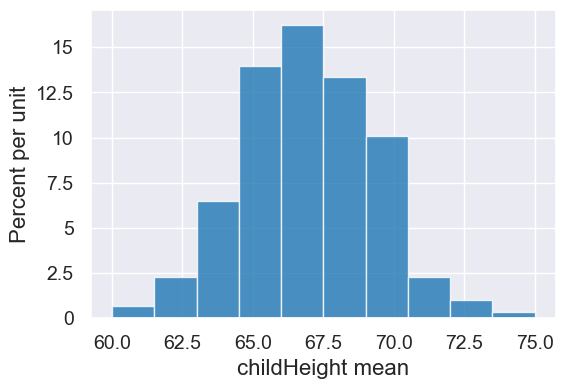Groups
Contents
Groups#
from datascience import *
from cs104 import *
import numpy as np
%matplotlib inline
1. Functions#
Apply#
heights_original = Table().read_table('data/galton.csv')
heights = heights_original.select('father', 'mother', 'childHeight')
heights = heights.relabeled('childHeight', 'child')
heights.show(5)
| father | mother | child |
|---|---|---|
| 78.5 | 67 | 73.2 |
| 78.5 | 67 | 69.2 |
| 78.5 | 67 | 69 |
| 78.5 | 67 | 69 |
| 75.5 | 66.5 | 73.5 |
... (929 rows omitted)
heights.hist('child')
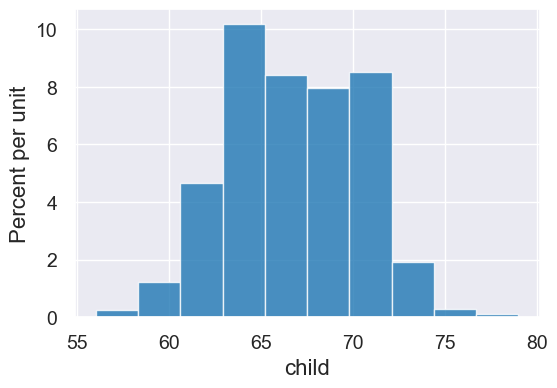
There are times we want to perform mathematical operations columns of the table but can’t use array broadcasting…
min(heights.column('child'), 72) # will cause an error
---------------------------------------------------------------------------
ValueError Traceback (most recent call last)
Cell In[7], line 1
----> 1 min(heights.column('child'), 72) # will cause an error
ValueError: The truth value of an array with more than one element is ambiguous. Use a.any() or a.all()
This is problematic because we cannot use array broadcasting with min in this way:
min(make_array(70, 73, 69), 72) #should be an error
---------------------------------------------------------------------------
ValueError Traceback (most recent call last)
Cell In[8], line 1
----> 1 min(make_array(70, 73, 69), 72) #should be an error
ValueError: The truth value of an array with more than one element is ambiguous. Use a.any() or a.all()
Instead, define our operation on a single value first:
def cut_off_at_72(x):
"""The smaller of x and 72"""
return min(x, 72)
cut_off_at_72(62)
62
cut_off_at_72(72)
72
cut_off_at_72(78)
72
The table apply method can then apply such a function to every entry in a column.
cut_off = heights.apply(cut_off_at_72, 'child')
height2 = heights.with_columns('child', cut_off)
height2.hist('child')
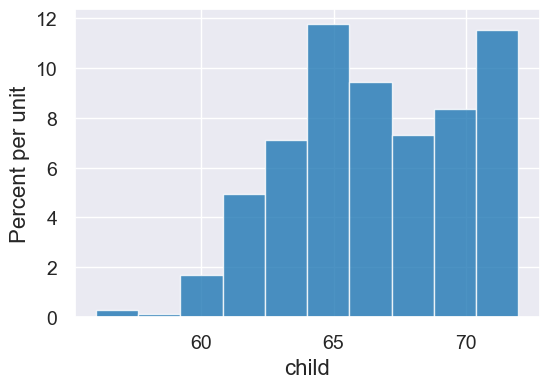
Apply with multiple columns#
heights.show(6)
| father | mother | child |
|---|---|---|
| 78.5 | 67 | 73.2 |
| 78.5 | 67 | 69.2 |
| 78.5 | 67 | 69 |
| 78.5 | 67 | 69 |
| 75.5 | 66.5 | 73.5 |
| 75.5 | 66.5 | 72.5 |
... (928 rows omitted)
def average(x, y):
"""Compute the average of two values"""
return (x + y) / 2
parent_avg = heights.apply(average, 'mother', 'father')
parent_avg.take(np.arange(0, 6))
array([72.75, 72.75, 72.75, 72.75, 71. , 71. ])
heights = heights.with_columns(
'parent average', parent_avg
)
heights
| father | mother | child | parent average |
|---|---|---|---|
| 78.5 | 67 | 73.2 | 72.75 |
| 78.5 | 67 | 69.2 | 72.75 |
| 78.5 | 67 | 69 | 72.75 |
| 78.5 | 67 | 69 | 72.75 |
| 75.5 | 66.5 | 73.5 | 71 |
| 75.5 | 66.5 | 72.5 | 71 |
| 75.5 | 66.5 | 65.5 | 71 |
| 75.5 | 66.5 | 65.5 | 71 |
| 75 | 64 | 71 | 69.5 |
| 75 | 64 | 68 | 69.5 |
... (924 rows omitted)
heights.scatter('parent average', 'child')
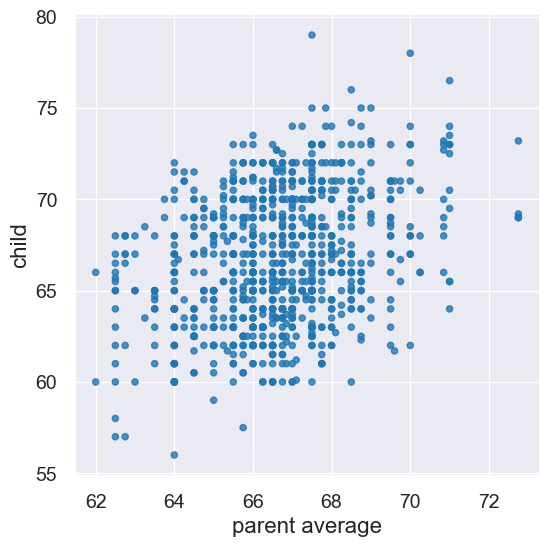
2. Predicting heights using functions and apply#
We’re following the example in Ch. 8.1.3
Think-pair-share: Suppose researchers encountered a new couple, similar to those in this dataset, and wondered how tall their child would be once their child grew up. What would be a good way to predict the child’s height, given that the parent average height was, say, 68 inches?
plot = heights.scatter('parent average', 'child')
plot.line(68, color='orange', linestyle='--', lw=2);
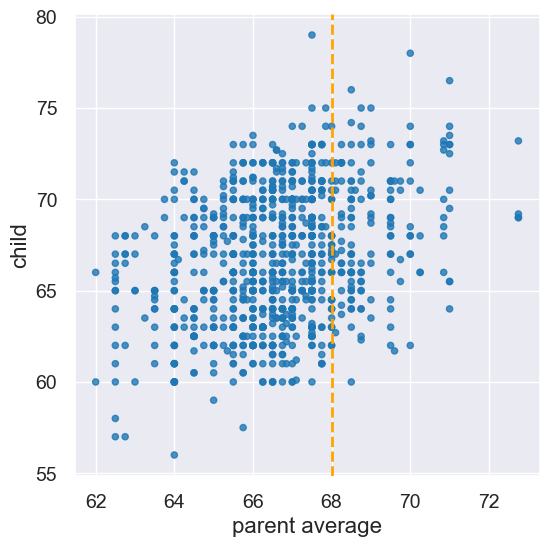
A: One initial approach would be to base the prediction on all observations (child, parent pairs) that are “close to” 68 inches for the parent.
Let’s take “close to” to mean within a half-inch
Let’s draw these with red lines
parent_avg_height = 68
close = 0.5
plot = heights.scatter('parent average', 'child')
plot.line(x=parent_avg_height - close, color='red', lw=1)
plot.line(x=parent_avg_height + close, color='red', lw=1)
plot.line(parent_avg_height, color='orange', linestyle='--', lw=2)
plot.dot(x=parent_avg_height, y=67.62, color='orange')
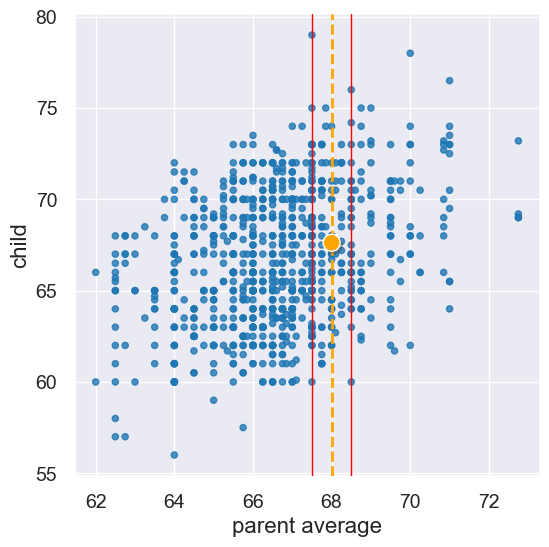
Let’s now identify all points within that red strip.
close_to_68 = heights.where('parent average',
are.between(parent_avg_height - close,
parent_avg_height + close))
close_to_68
| father | mother | child | parent average |
|---|---|---|---|
| 74 | 62 | 74 | 68 |
| 74 | 62 | 70 | 68 |
| 74 | 62 | 68 | 68 |
| 74 | 62 | 67 | 68 |
| 74 | 62 | 67 | 68 |
| 74 | 62 | 66 | 68 |
| 74 | 62 | 63.5 | 68 |
| 74 | 62 | 63 | 68 |
| 74 | 61 | 65 | 67.5 |
| 73.2 | 63 | 62.7 | 68.1 |
... (175 rows omitted)
And take the average to make a prediction about the child.
np.average(close_to_68.column('child'))
67.62
Ooo! Let’s write a function to compute that child mean height for any parent average height
def predict_child(parent_avg_height):
close = 0.5
close_points = heights.where('parent average',
are.between(parent_avg_height - close,
parent_avg_height + close))
return np.mean(close_points.column('child'))
predict_child(68)
67.62
predict_child(65)
65.83829787234043
Apply predict_child to all the parent averages.
predicted = heights.apply(predict_child, 'parent average')
predicted.take(np.arange(0,10))
array([70.1 , 70.1 , 70.1 , 70.1 , 70.41578947,
70.41578947, 70.41578947, 70.41578947, 68.5025 , 68.5025 ])
Now, let’s extend this table with these new predictions.
height_pred = heights.with_columns('prediction', predicted)
height_pred.select('child', 'parent average', 'prediction').scatter('parent average')
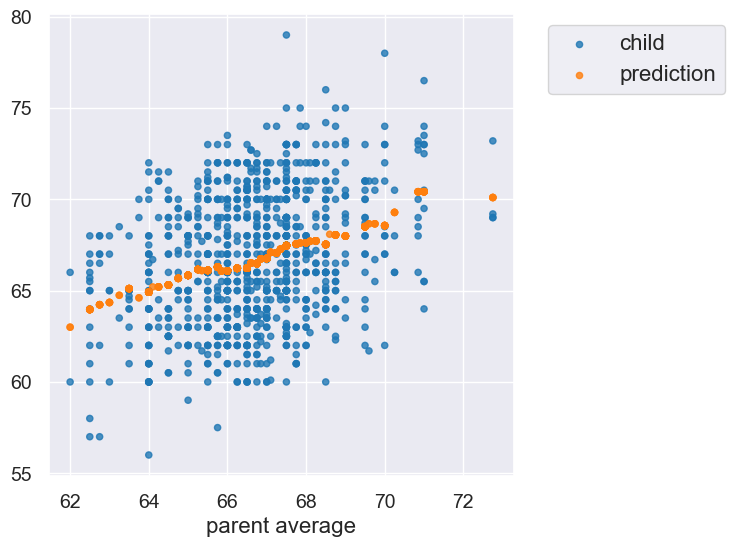
Preview: Throughout this course we’ll keep moving towards making our predictions better!
Extra: How close is close enough for prediction?#
The choice of say two heights are “close to” eachother if they are within a half-inch was a somewhat arbitrary choice. We chould have chosen other values instead. What would happen if we changed that constant to be 0.25, 1, 2, or 5?
This visualization demostrates the impact that choice has on our predictions. The visualize_predictions function plots the prediction for each child height using a window of parent average height +/- delta.
from functools import lru_cache as cache
@cache # saves tables for each delta we compute to avoid recomputing.
def vary_range(delta):
"""Use a window of +/- delta when predicting child heights."""
def predict_child(parent_avg_height):
close_points = heights.where('parent average',
are.between(parent_avg_height - delta,
parent_avg_height + delta))
return np.mean(close_points.column('child'))
predicted = heights.apply(predict_child, 'parent average')
height_pred = heights.with_columns('prediction', predicted)
return height_pred.select('child', 'parent average', 'prediction')
def visualize_predictions(delta = 0.5):
predictions = vary_range(delta)
predictions.scatter('parent average', s=50, width=6, height=4) # make dots a little bigger than usual
interact(visualize_predictions, delta = Slider(0, 10, 0.125))
Here’s an animation that demostrates the impact that our choice of “close enough” has on our predictions. As you can see, if it’s very small, there is a lot of variability in the prediction. If it’s very large, the prediction can be pretty far off from the mean for a given height.
3. Groups with Scrabble#
Let’s load a table of 98 tiles from Scrabble. (We’ll exclude the two blank tiles from the full set of 100.)
scrabble_tiles = Table().read_table('data/scrabble_tiles.csv')
scrabble_tiles.sample(10)
| Letter | Score | Vowel |
|---|---|---|
| R | 1 | No |
| I | 1 | Yes |
| E | 1 | Yes |
| T | 1 | No |
| S | 1 | No |
| E | 1 | Yes |
| A | 1 | Yes |
| D | 2 | No |
| R | 1 | No |
| R | 1 | No |
We must often divide rows into groups according to some feature, and then compute a basic characteristic for each resulting group.
scrabble_tiles.group('Letter')
| Letter | count |
|---|---|
| A | 9 |
| B | 2 |
| C | 2 |
| D | 4 |
| E | 12 |
| F | 2 |
| G | 3 |
| H | 2 |
| I | 9 |
| J | 1 |
... (16 rows omitted)
scrabble_tiles.group('Vowel')
| Vowel | count |
|---|---|
| No | 56 |
| Yes | 42 |
scrabble_tiles.group('Vowel', sum)
| Vowel | Letter sum | Score sum |
|---|---|---|
| No | 145 | |
| Yes | 42 |
Notes:
When we pass in a function to
groupthat is not the default (e.g.sum), the name of that function is appended to the column name.Some of the columns are empty because
sumcan only be applied to numerical (not categorial) variables. Our package is smart about this and leaves the columns empty (e.g.Letter sum).
scrabble_tiles.group('Vowel', max)
| Vowel | Letter max | Score max |
|---|---|---|
| No | Z | 10 |
| Yes | U | 1 |
Applying aggregation functions (e.g.
max) to some columns (e.g.Letter) are not meaningful. That’s ok. But we’ll have to use our understanding about the dataset to ignore these aggregations.
Group multiple columns#
small_scrabble = scrabble_tiles.sample(10)
small_scrabble = small_scrabble.with_columns('Used',
make_array('Yes', 'Yes', 'Yes', 'No', 'No',
'No', 'No', 'No', 'No', 'No'))
small_scrabble
| Letter | Score | Vowel | Used |
|---|---|---|---|
| O | 1 | Yes | Yes |
| O | 1 | Yes | Yes |
| Y | 4 | No | Yes |
| A | 1 | Yes | No |
| T | 1 | No | No |
| O | 1 | Yes | No |
| V | 4 | No | No |
| U | 1 | Yes | No |
| I | 1 | Yes | No |
| Q | 10 | No | No |
Q: How many vowels do I have left that I have not used?
small_scrabble.group(make_array('Vowel', 'Used'))
| Vowel | Used | count |
|---|---|---|
| No | No | 3 |
| No | Yes | 1 |
| Yes | No | 4 |
| Yes | Yes | 2 |
Q: What’s the total score of the non-vowels I have used and not used?
small_scrabble.group(make_array('Vowel', 'Used'), sum)
| Vowel | Used | Letter sum | Score sum |
|---|---|---|---|
| No | No | 15 | |
| No | Yes | 4 | |
| Yes | No | 4 | |
| Yes | Yes | 2 |
4. Groups with heights#
heights_original.show(3)
| family | father | mother | midparentHeight | children | childNum | gender | childHeight |
|---|---|---|---|---|---|---|---|
| 1 | 78.5 | 67 | 75.43 | 4 | 1 | male | 73.2 |
| 1 | 78.5 | 67 | 75.43 | 4 | 2 | female | 69.2 |
| 1 | 78.5 | 67 | 75.43 | 4 | 3 | female | 69 |
... (931 rows omitted)
Q: How many children does each family have?
by_family = heights_original.group('family')
by_family.show(5)
| family | count |
|---|---|
| 1 | 4 |
| 10 | 1 |
| 100 | 3 |
| 101 | 4 |
| 102 | 6 |
... (200 rows omitted)
Let’s relabel based on what we know about this particular dataset (each row is a child).
by_family = by_family.relabeled("count", "number of children")
by_family.hist("number of children", bins=15)
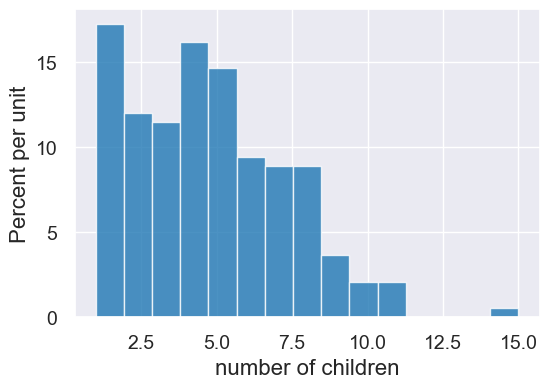
Q: Per family, what is the average height of the children?
by_family = heights_original.select('family', 'childHeight').group('family', np.mean)
by_family.show(5)
by_family.hist('childHeight mean')
| family | childHeight mean |
|---|---|
| 1 | 70.1 |
| 10 | 65.5 |
| 100 | 70.7333 |
| 101 | 72.375 |
| 102 | 66.1667 |
... (200 rows omitted)
